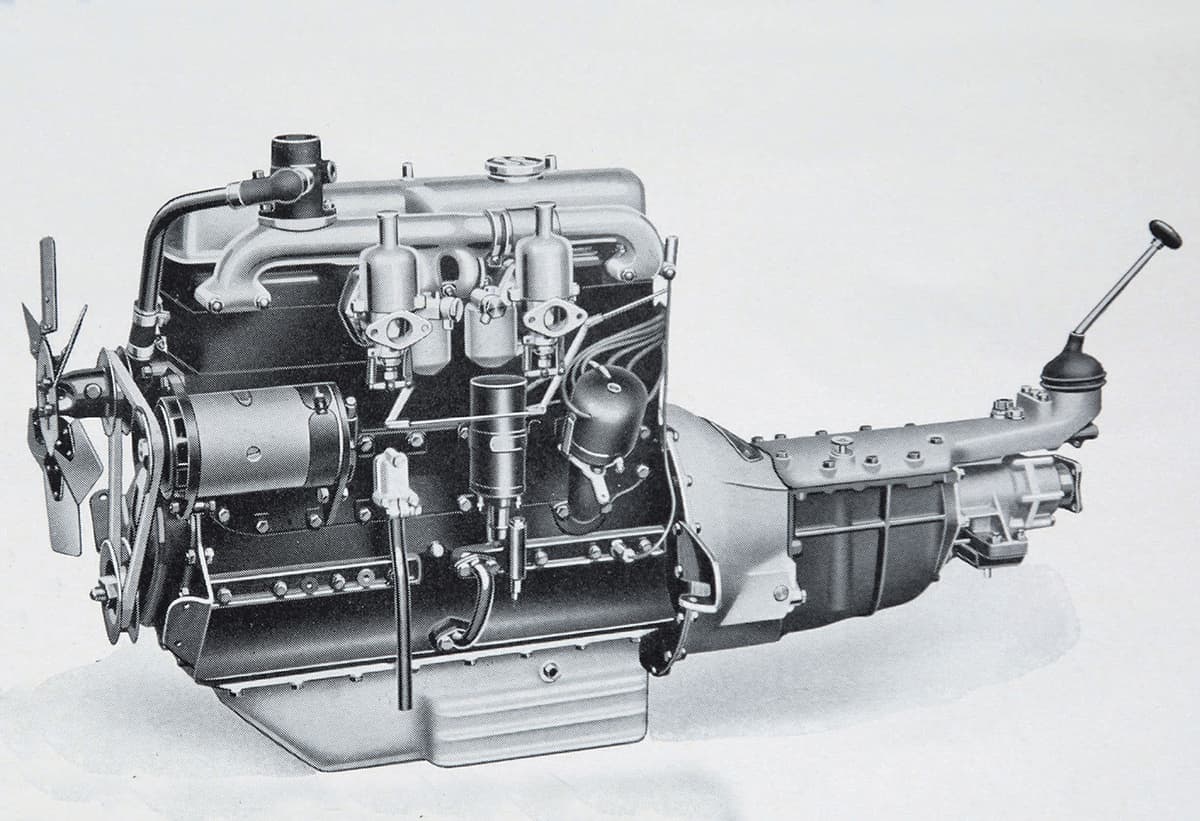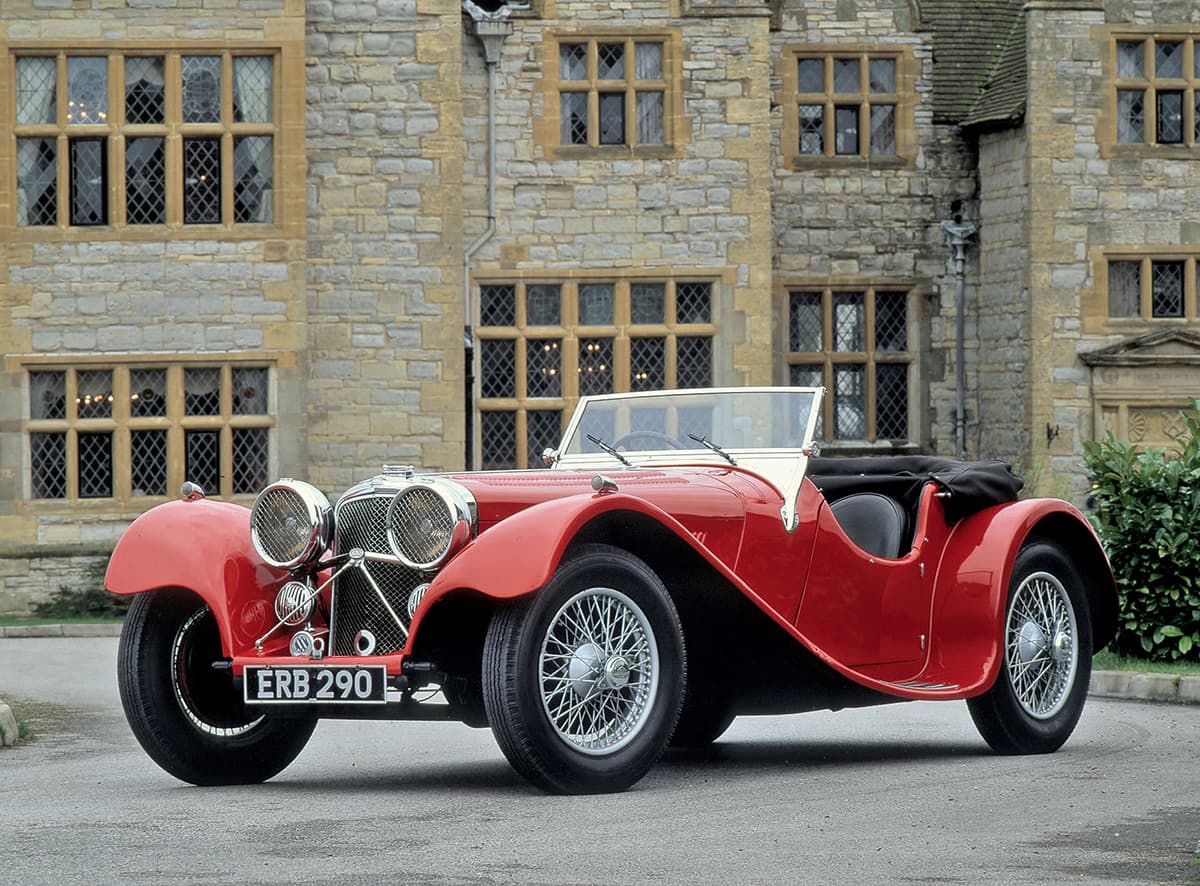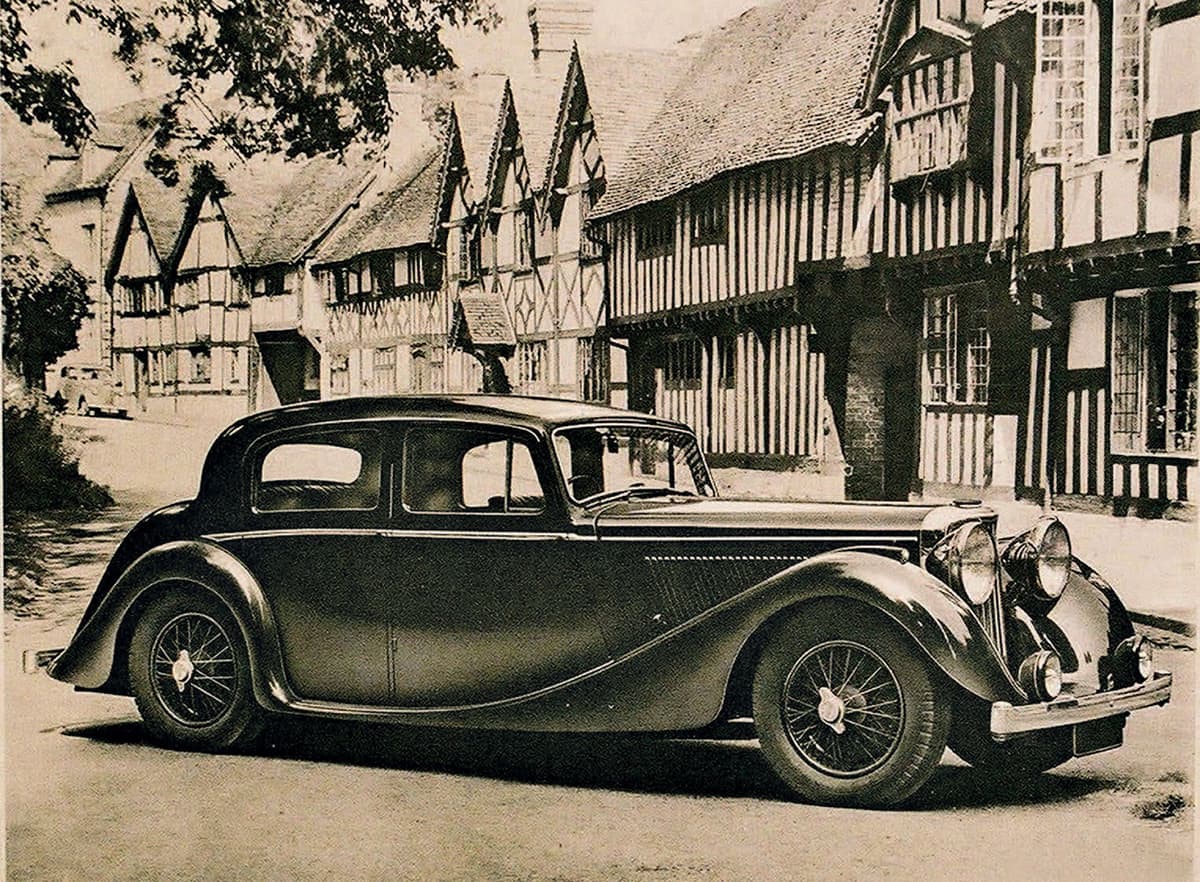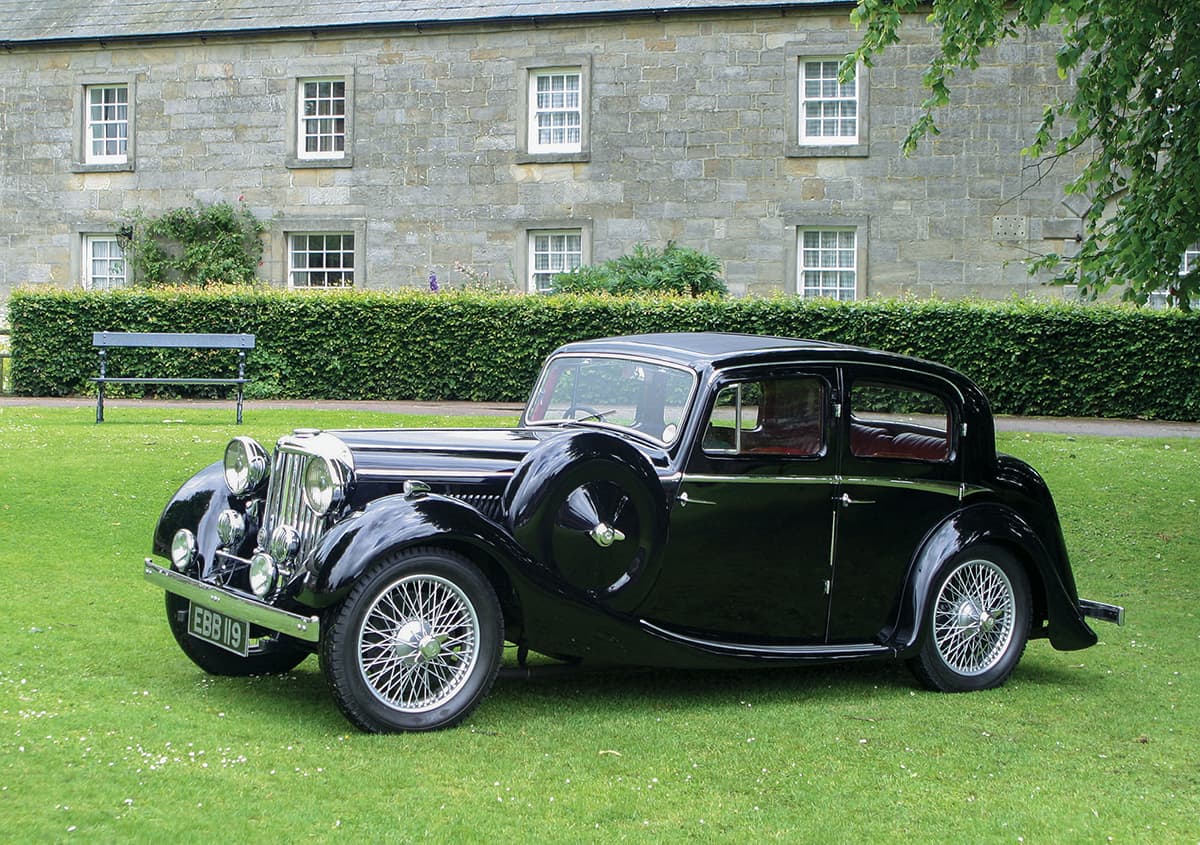CHAPTER ONE
MODEL TO MARQUE
The Early Pushrods
Spurred by the success of his Standard-based SS models, William Lyons set about designing an entirely new car that would require a new name, although at this point not a brand name in its own right, but merely a model name epitomizing the essence of the car. Used in contemporary culture, and in pre-Columbian Central and South America, as a symbol of power and strength, the jaguar’s speed and predatory nature made it a widely feared animal. The stealthy and streamlined look of the pouncing cat was the perfect emblem for Lyons’s new car.
1935: Introducing a New Car and a New Name.
Lyons’s Jaguar was a completely new design and a very advanced project for such a fledgling company. The first aspect Lyons focused on was the chassis. Produced for SS by the Standard Motor Company, but to Lyons’s own design, the chassis would accept a new four-door sports saloon body style, also designed by him.
Standard’s engines produced insufficient power for Lyons’s needs, so he employed the services of Harry Weslake, one of the foremost motoring engineers of the day. Weslake redesigned the Standard side-valve engines to an overhead valve arrangement, improving their efficiency and performance considerably. Standard agreed to manufacture two new engines—a 2.5-liter six cylinder and a 1.5-liter four cylinder—on the understanding that the six would be exclusively for SS use, but that the smaller unit could be used in forthcoming new Standard models as well.

The first-generation SS Jaguar 2.5-liter saloon as it was launched from 1936, with a side-mounted spare wheel that would have had a cover originally. The radiator mascot was an option.

The overhead-valve six-cylinder engine designed by Harry Weslake for SS, seen here in 2.5-liter form.
Offering an all-new chassis, stylish sports saloon bodywork, and the choice of the two engines, the new SS Jaguar models were launched to an audience of respected British motor industry experts and journalists at the Mayfair Hotel in London in September 1935. After viewing the 2.5-liter model on a plinth in the dining room and being told of its specification, the tables were supplied with paper and pencils for the gathering to estimate the price at which this new car was to be sold in 1936. No one in attendance came close to the true figure of £385. In fact, few believed it possible to produce such an advanced car at that price. Lyons proved them wrong and the SS Jaguar was a success.
With the introduction of the SS Jaguars, production of all SS1 and SS2 cars ceased except for the two-door, six-cylinder Tourer, which was renamed SS Jaguar Tourer and fitted with the overhead-valve 2.5-liter engine.
1936–1937: The New Kid on the Block
Production of the new models got underway immediately, initially with the two four-door saloon models and then with the addition of a two-seater sports car (derived from the mechanics of the saloons): the SS Jaguar 100. This rakish sports car was very much styled on similar sports cars of the period (including a low-production SS90 based on the SS1), with its swept-back wing design, prominent chromed radiator grille surround, and tripod headlights. It gave an incredible visual impact. Initially there was only one 100 model with the 2.5-liter engine.
Although produced in small numbers, the SS Jaguar 100 created considerable buzz for the company and its products, enhancing its reputation for fine cars.
1937–1940: Metal to Metal
Initial sales of the saloons were promising, so much so that there was a need to streamline production. Demand would increase further with the provision of extra models. The renamed Tourer was discontinued after only 125 were produced, as it didn’t fit with production changes the company was about to implement.
The SS Jaguar saloons were initially built in the traditional expensive and time-consuming manner of steel panels grafted onto an ash wooden framework. All-steel bodyshells were the way forward, which SS adopted late in 1937.
At the same time, SS introduced two-door drophead coupe versions of all the saloons, but as the numbers produced would be much smaller and a degree of handcrafting was required, traditional build methods continued for these cars.
SS also introduced a third new engine, a 3.5-liter, to the range, based on the six-cylinder unit. This engine was very much a high-performance model capable of propelling cars to speeds above 90 miles per hour. Available for the 1938 model year, the 3.5-liter found a home in the saloon and drophead coupe, as well as the SS Jaguar 100 sports.
The final upgrade to the model line came when displacement of the 1.5-liter four-cylinder engine was increased to 1.75 liters.
All models continued in production alongside sidecar manufacture until the outbreak of World War II, when civilian vehicle production was turned over to the war effort.
The company’s first era ended with its move from Lancashire to Warwickshire. Since the introduction of the model name Jaguar in 1935, the company had produced a total of 14,359 cars. Numerous changes awaited after World War II, not least the adoption of Jaguar as the company and brand name.

The new chassis designed to accept the overhead-valve engine and the stylish saloon coachwork.

The beautiful SS Jaguar 100 sports car was available for a limited period prewar with either the 2.5- or 3.5-liter engine.

By the end of 1937, a larger-engined 3.5-liter model was added to the range, requiring a longer bonnet. At the same time, all models lost the side-mounted spare wheel.

The early instrument layout for prewar models. Note, too, the arrival of the four-spoke steering wheel that became a traditional feature on the company’s cars for many years.

The 1.5-liter (later 1.75-liter) SS Jaguar with a shallower and lower bonnet that makes the side-mounted spare wheel stand proud. The metal spare-wheel cover was standard on all these cars until the introduction of the steel-bodied versions.

One of the virtually hand-built drophead coupe models from the SS Jaguar range, initially available in all three engine sizes. Here the roof is unfurled into the sedanca position, allowing the driver and front seat passenger to take in the fresh air while leaving the rear seat passengers with cover.
x
MODEL |
SS Jaguar 1.5-liter Saloon |
SS Jaguar 2.5-liter Saloon |
SS Jaguar 3.5-liter Saloon |
ENGINE SIZE |
1,608cc |
2,663cc |
3,485cc |
CARBURETION |
Single Solex |
2 x 1.25 SU |
2 x 1.5 SU |
MAX BHP |
52@4,300 |
102@4,600 |
125@4,500 |
MAX TORQUE |
Not stated |
Not stated |
Not stated |
GEARBOX |
4-speed |
4-speed |
4-speed |
AUTOMATIC |
n/a |
n/a |
n/a |
0 TO 60 MPH |
33 sec. |
17.5 sec. |
10 sec. |
STANDING 1/4 MILE |
24 sec. |
20 sec. |
19.4 sec. |
TOP SPEED |
70 mph |
85 mph |
92 mph |
AVERAGE FUEL CONSUMPTION |
25 mpg |
21 mpg |
18 mpg |
MODEL |
SS100 2.5-liter Saloon |
SS100 3.5-liter Saloon |
ENGINE SIZE |
2,663cc |
3,485cc |
CARBURETION |
2 x 1.5 SU |
2 x 1.5 SU |
MAX BHP |
102@4,600 |
125@4,250 |
MAX TORQUE |
Not stated |
Not stated |
GEARBOX |
4-speed |
4-speed |
AUTOMATIC |
n/a |
n/a |
0 TO 60 MPH |
12.8 sec. |
10.9 sec. |
STANDING 1/4 MILE |
18.6 sec. |
17.1 sec. |
TOP SPEED |
94 mph |
101 mph |
AVERAGE FUEL CONSUMPTION |
20 mpg |
20 mpg |